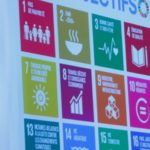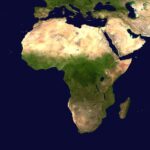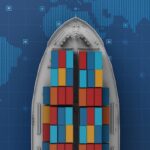ABSTRACT
The African Continental Free Trade Area—AfCFTA agreement will create a major free trade area (FTA) in the world, connecting 1.3 billion people across 55 countries with a collective gross domestic product (GDP) valued at US$3.4 trillion. Thirty million people are expected to be lifted out of extreme poverty if significant policy reforms and trade facilitation measures are adopted.
Studies have shown the positives of AfCFTA. Nonetheless, there are challenges potent enough to upend the benefits of Africa’s FTA. The resolve of this paper is to identify some of the several potent challenges the AfCFTA is facing in the ECOWAS trade bloc and objectively proffer policy advice that could assist the FTA to succeed in this Regional Economic Community (REC).
With approximately USD 600 billion GDP and a significant migration flow, the ECOWAS stands as one of the most dynamic RECs. In 2016, the region posted approximately USD 11 billion in trade value.
Some of the identified barriers revealed in this study were non-cooperative policy directives among member states of the ECOWAS bloc, internal conflicts and unrests causing boundary restrictions, non-tariff barriers, and poor intra and -inter infrastructural capacity among member states.
For AfCFTA to work in the ECOWAS trade bloc, it must adopt working processes from other successful FTAs to achieve its set objectives. Such mechanisms include competition policies, the rules of origin principles, and improved intra-African investments and promote industrial development, resist external abuse from the dumping of goods by creating conditions for increased manufacturing capacity, coordination of trade and tariff policies, planning critical enabling infrastructure, and identifying sources of low-interest capital needed to fund industrial production.
INTRODUCTION
The African Continental Free Trade Area—AfCFTA treaty will create one of the largest free trade area (FTA) in the world measured by the number of countries participating. It will connect 1.3 billion people across 55 countries with a combined gross domestic product (GDP) valued at US$3.4 trillion. Thirty million people are expected to lift out of extreme poverty, but achieving its full potential will depend on significant policy reforms and trade facilitation measures.[i]
AfCFTA is the African model of a Free Trade Area (FTA), which allows specific groups—countries in a region or group of regions to trade through a treaty or memoranda of agreement (MoA), impressing the agenda for economic cooperation among them. FTA’s are primarily established by a forum of nations to lower or remove Barriers to Trade (BT) by implementing Non-Barrier to Trade Agreements (NBTs) specifically on tariffs and import quotas, allowing the free trade of goods and services among signatory states.[ii]
Studies have shown the positives of AfCFTA. Notwithstanding, there are existing posing challenges powerful enough to upend the benefits of Africa’s FTA. The resolve of this paper is to identify some of the several potent challenges the AfCFTA is facing in the ECOWAS[iii] trade bloc and objectively proffer policy advice that could assist the FTA to succeed in this Regional Economic Community (REC).[iv]
HISTORICAL BACKGROUND OF AfCFTA
Africa’s desire for development and economic growth did not start with AfCFTA. African countries under the auspices of the African Union had developed several growth agendas such as NEPAD[v] and AGOA.[vi]The OAU adopted the New Partnership for Africa’s Development (NEPAD) in 2001 and was endorsed by the African Union in 2002 to address the continent’s development challenges in poverty reduction and sustainable development and empower women.
AGOA, on the other hand, was an initiative of the US, and it stimulated Africa’s exports until 2008. It had a drawback that non-oil exports from Africa underperformed. However, it enabled some diversification and industrial growth in partner countries that saw exports of manufactured goods to the US increase by around USD 1.6 billion in real terms between 2001 and 2001. Under AfCFTA, an increase in Africa’s GDP is expected, further increasing the attractiveness of the African market to FDIs.
AfCFTA is the leading project of the African Union’s Agenda 2063, a plan for attaining inclusive[vii] and sustainable development over the next fifty years adopted at the eighteenth Ordinary Session of the AU in Addis Ababa, Ethiopia in January 2012 by Heads of State and Government of the African Union. Five operational instruments will govern the AfCFTA: the Rules of Origin (RoR); the online converting forum; a digital payments system; the monitoring and elimination of non-tariff barriers; and the African Trade Observatory.[viii]
The AfCFTA will encompass the fifty-five Africa countries[ix] with a population of over a billion people and a combined GDP of over USD 3 trillion, according to 2014 data.[x]According to the World Bank report[xi] and the IMF staff discussion notes[xii] of 2020, affecting AfCFT-Agreement represents an essential opportunity for several African economies to improve growth indices, reduce poverty, and broaden economic inclusion. AfCFTA would potentially improve economic benefits for African countries.[xiii]
It is expected that about 30 million Africans would be lifted out of extreme poverty, including 68 million more who live on less than USD 5.50 a day. By 2035, African economies are expected to record an increase in trade output of about 7%, translating to about USD 450 billion while adding about USD 76 billion to world trade. Analysts also believe that manufacturing would take center stage and amount to about USD 560 billion, improving technology and labor skills by about 10.3% for unskilled and 9.8% for skilled workers. An anticipated increased income of about 10% for women and 9.9% for men has also been forecasted for the continent.[xiv]
The 2019 Ibrahim Forum Report stressed that Africa’s most urgent challenge is declining opportunities and unemployment in its teeming youth population in the face of Africa’s growth in the last decade. Youths consider unemployment by far the most confronting uphill task for their governments to address.[xv]
AfCFTA: CONCERNS AND CHALLENGES TO ITS CONTINENTAL REALIZATION
According to Fasan, Africa is moving too slowly towards economic integration than the rest of the world.[xvi] Africa is characterized by weak trade integration, particularly with the rest of the world.[xvii]Africa remains a fragmented continent with infrastructure gridlocks and bureaucracy with very high trade costs due to the lack of integration. High tariff barriers averaging 8.7% and, more perniciously, non-tariff barriers and poor harmonization of standards hampers business across Africa[xviii], underpinning low intra-Africa trade and pushing trade in Africa into predominantly informal channels.[xix]One of the crucial rationales behind the creation of AfCFTA was to deepen integration. In 2011, the AU Assembly adopted the Action Plan for Boosting Intra-Africa Trade (BIAT), AfCFTA a free trade area, lesser to either a single market or a customs union. The AfCFTA’s objectives are, among other things, to “create a single market” and “lay the foundations for instituting a Continental Customs Union” Under the Abuja Treaty of 1991.[xx]
The African production problem with manufacturing was precipitated by difficulties to build initiatives that can compete in the global space due to the paucity of funds for investments that allow for economies of scale and the vulnerability to dumping from countries with lower operating costs, better technology, and innovative capacities.[xxi]
Currently, RECs—ECOWAS, EAS, and SADC[xxii] have the challenge of low trade volumes. An improvement can be made if African economies consider value additions from raw material value chains to increase Regional Value Content (RVCs). Secondly, the AfCFTA has not guaranteed direct free trade between countries. For example, Nigeria closed its borders to its neighbors on the west in 2019.[xxiii] African nations yet see as a priority protecting their various local producers as compared to trade liberalization. Thirdly, sanitary and phytosanitary measures may push the barrier to market access for small-scale producers, especially those who sell agricultural products. Lastly, transportation infrastructure in the African continent is yet poor, and massive investments are required to improve country-to-country connections for smooth logistics of goods.[xxiv]
CHALLENGES AND NON-DRIVERS OF AFCFTA: ECOWAS IN FOCUS
No sooner than the agreement on AfCFTA was signed than the challenges that could upend its goals came up. With approximately USD 600 billion GDP and a significant migration flow, the ECOWAS stands as one of the most dynamic RECs. In 2016, the ECOWAS region posted approximately USD 11 billion in trade value.[xxv] These facts explain the critical role played by ECOWAS in the AfCFTA negotiations.[xxvi] Some of the challenges identified are primarily in harmonizing standards as a customs union, policy disagreements causing trade barriers (TBs), non-players of key economies in the agreement, such as Nigeria.[xxvii]
The founding of the ECOWAS Common External Tariff (CET) was to serve the purpose of intensifying and deepening the poor state of economic integration first, through an FTA with ECOWAS Trade Liberalization Scheme (ETLS)[xxviii] and proceeding to a Common Union (CU) through a legal mandate derived from Article 3 of ECOWAS Revised Treaty of 1993.[xxix] There are eight RECs in Africa who operate FTAs. However, among these, the ECOWAS REC bloc is considered pivotal to the success of other RECs.[xxx] The current challenge in integrating AfCFTA and ECOWAS-REC must be resolved.[xxxi]
Other critical challenges to the AfCFTA-ECOWAS union are poor internal insecurity, crime, illicit trading, and smuggling across the borders. In August 2019, the Nigerian government closed its borders against its neighbors to stem extensive trafficking across its borders and perhaps the exportation of insurgency.[xxxii] The complications of bad governance, corruption, insecurity, poverty, and unemployment remain rife across ECOWAS member states.[xxxiii] To improve regional integration, national interests should be based on the substantive implementation of the agreed-upon economic and trade provisions that allow for economic development and investments in the region. ECOWAS should focus on public-private-partnerships (PPPs) that support multiple levels of exchange of ideas creating business in both physical goods and services,[xxxiv] treaties with other RECs which ensures the free movement of people and capital, and the disambiguation of the ECOWAS by the AfCFTA and its institutions to remove any future contentions. A good example, is the North American Free Trade Agreement (NAFTA) was signed in 1992, and the Canada-United States Free Trade Agreement (CUSFTA) was in force between 1987 and 1994.[xxxv]
POLICY RECOMMENDATIONS
The World Bank disclosed that the AfCFTA is a USD 3.4 trillion market with the potential of lifting about 30 million Africans out of extreme poverty.[xxxvi] For AfCFTA to work, it must adopt working processes from other successful FTAs to achieve its set objectives. Such mechanisms include competition policies, the rules of origin principles, and improved intra-African investments.[xxxvii] Some of these instruments are currently in force in certain regional free trade areas across the continent, also known as Regional Economic Communities (RECs).[xxxviii] To promote industrial development through AfCFTA, ECOWAS must resist external abuse of this economy. For example, from the dumping of goods by creating conditions for increased manufacturing capacity, coordination of trade and tariff policies, planning critical enabling infrastructure and identifying sources of low-interest capital needed to fund industrial production. Identify “Winners” who have a high comparative advantage to produce some certain goods and services, set up an African financing Institution to fund infrastructure and industry, and more importantly, give compulsory regular progress reports every five years.[xxxix]
The African industrial policy would do better with reports evaluating critical indicators of industrialization and manufacturing capacity. Africa has traditionally suffered from its incapacity to sustain well-intentioned initiatives. Besides, the emphasis on the key performance indicators being measured can be used to incentivize positive outcomes.[xl]
CONCLUSION
The relationship between the AfCFTA and the ECOWAS bloc has been a topic of debate since the signing of the agreement. The AfCFTA agreement came into force with opposing factors that could challenge its success, first to the signatory states and second to the ECOWAS bloc, the focus of this study. Some of the identified barriers revealed in this study were non-cooperative policy directives among member states of ECOWAS, internal conflicts and unrests causing boundary restrictions, infrastructure gridlocks and bureaucracy, and poor harmonization of standards. AfCFTA’s focal intentions are to create a single continental marketplace for free goods and services investments. However, in light of the difficulties encountered by most of Africa’s RECs in advancing their integration processes at the sub-regional level, establishing a single functional market between all fifty-five Africa countries will be uniquely tricky. AfCFTA will not influence all partner countries in the same way. Therefore, there will be winners and losers requiring that an adequate compensation mechanism be set in place.
REFERENCES
[i]World Bank, “The African Continental Free Trade Area,” World Bank, last modified July 27, 2020, accessed October 22, 2021, https://www.worldbank.org/en/topic/trade/publication/the-african-continental-free-trade-area.
[ii]“Free Trade Area,” Corporate Finance Institute, accessed October 12, 2021, https://corporatefinanceinstitute.com/resources/knowledge/economics/free-trade-area/.
[iii]“The African Continental Free Trade Area and the Regional Economic Communities (Focus on ECOWAS),” LEX Africa, February 23, 2021, accessed October 12, 2021, https://www.lexafrica.com/2021/02/the-african-continental-free-trade-area-and-the-regional-economic-communities-focus-on-ecowas/.
[iv]“Regional Economic Communities (RECs) | African Union,” accessed October 22, 2021, https://au.int/en/organs/recs.
[v]“New Partnership for Africa’s Development – NEPAD | Poverty Eradication,” accessed October 25, 2021, https://www.un.org/development/desa/socialperspectiveondevelopment/issues/new-partnership-for-africas-development-nepad.html.
[vi]William Davis, “THE AFRICAN GROWTH AND OPPORTUNITY ACT AND THE AFRICAN CONTINENTAL FREE TRADE AREA,” AJIL Unbound 111 (2017): 377–383.
[vii]Jaime de Melo, “The Africa Continental Free Trade Area: An Opportunity to Deepen Cooperation on Regional Public Goods,” Brookings, March 4, 2019, accessed October 12, 2021, https://www.brookings.edu/blog/future-development/2019/03/04/the-africa-continental-free-trade-area-an-opportunity-to-deepen-cooperation-on-regional-public-goods/.
[viii]“African Continental Free Trade Area (AfCFTA) Legal Texts and Policy Documents – Tralac Trade Law Centre,” accessed October 12, 2021, https://www.tralac.org/resources/our-resources/6730-continental-free-trade-area-cfta.html.
[ix]Jamie de Melo, “Africa’s Continental Free Trade Area: Progress and Challenges,” LSE Business Review, April 5, 2019, accessed October 15, 2021, https://blogs.lse.ac.uk/businessreview/2019/04/05/africas-continental-free-trade-area-progress-and-challenges/.
[x]Desalegn Deresso Disassa, Continental Free Trade Area of Africa: Challenges and Prospects, SSRN Scholarly Paper (Rochester, NY: Social Science Research Network, January 8, 2019), 6, accessed October 13, 2021, https://papers.ssrn.com/abstract=3312195.
[xi]World Bank, “The African Continental Free Trade Area.”
[xii]“The African Continental Free Trade Area: Potential Economic Impact and Challenges,” IMF, accessed October 18, 2021, https://www.imf.org/en/Publications/Staff-Discussion-Notes/Issues/2020/05/13/The-African-Continental-Free-Trade-Area-Potential-Economic-Impact-and-Challenges-46235.
[xiii]Ibid.
[xiv]World Bank, The African Continental Free Trade Area: Economic and Distributional Effects (World Bank Group, 2020), 1–7, accessed October 25, 2021, https://openknowledge.worldbank.org/bitstream/handle/10986/34139/9781464815591.pdf.
[xv]“The African Continental Free Trade Area (AfCFTA): What’s in It for Africa’s Youth?,” Mo Ibrahim Foundation, accessed October 12, 2021, http://mo.ibrahim.foundation/news/2019/african-continental-free-trade-area-afcfta-whats-africas-youth.
[xvi]Olu Fasan, “AfCFTA: Africa Is Moving Too Slowly towards Economic Integration,” IGC, last modified February 18, 2019, accessed October 13, 2021, https://www.theigc.org/blog/afcfta-africa-is-moving-too-slowly-towards-economic-integration/.
[xvii]Antoine Bouët, Lionel Cosnard, and David Laborde, “Measuring Trade Integration in Africa,” Journal of Economic Integration 32, no. 4 (2017): 937.
[xviii]“Africa Is Launching AfCFTA, the World’s Largest Free Trade Area – but These Are the Stumbling Blocks,” World Economic Forum, accessed October 12, 2021, https://www.weforum.org/agenda/2019/09/africa-just-launched-the-world-s-largest-free-trade-area/.
[xix]Franklin Olakunle Amoo, “AfCFTA: A Free Trade Agreement with No Industries to Benefit,” last modified December 20, 2019, accessed October 17, 2021, https://www.stearsng.com/article/acfta-a-free-trade-agreement-with-no-industries-to-benefit.
[xx]Fasan, “AfCFTA.”
[xxi]Amoo, “AfCFTA.”
[xxii]“ECOWAS and the Role of the RECs in AfCFTA Implementation,” ECDPM, accessed October 12, 2021, https://ecdpm.org/great-insights/african-continental-free-trade-area-agreement-impact/ecowas-recs-afcfta-implementation/.
[xxiii]Stephen Golub Golubski Ahmadou Aly Mbaye, and Christina, “The Effects of Nigeria’s Closed Borders on Informal Trade with Benin,” Brookings, October 29, 2019, accessed October 26, 2021, https://www.brookings.edu/blog/africa-in-focus/2019/10/29/the-effects-of-nigerias-closed-borders-on-informal-trade-with-benin/.
[xxiv]Munsu Kang, Will the Afcfta Accelerate Inter-African Economic Integration?, SSRN Scholarly Paper (Rochester, NY: Social Science Research Network, December 21, 2020), accessed October 14, 2021, https://papers.ssrn.com/abstract=3901618.
[xxv] “Nigeria, Ecowas And The Road To The AfCFTA – International Law – Nigeria,” accessed October 12, 2021, https://www.mondaq.com/nigeria/international-trade-investment/895898/nigeria-ecowas-and-the-road-to-the-afcfta.
[xxvi] “The African Continental Free Trade Area and the Regional Economic Communities (Focus on ECOWAS).”
[xxvii]“The African Continental Free Trade Area,” ACCORD, n.d., accessed October 12, 2021, https://www.accord.org.za/conflict-trends/the-african-continental-free-trade-area/.
[xxviii] “ECOWAS Trade Liberalization Scheme (ETLS) – ECOWAS Trade Information System(ECOTIS),” n.d., accessed October 28, 2021, https://ecotis.projects.ecowas.int/policy-development/common-market-and-custom-union/.
[xxix]Wunmi Olayiwola, Governing the Interface between the African Continental Free Trade Area and Regional Economic Communities Free Trade Areas: Issues, Opportunities and Challenges (UNECA, November 2, 2020), 73, https://www.tralac.org/documents/resources/cfta/4229-governing-the-interface-between-the-afcfta-and-recs-ftas-issues-opportunities-and-challenges-uneca-november-2020/file.html.
[xxx]“Africa’s Free Trade Area Opens for Business,” Africa Renewal, last modified January 7, 2021, accessed October 12, 2021, https://www.un.org/africarenewal/magazine/january-2021/afcfta-africa-now-open-business.
[xxxi]“The African Continental Free Trade Area and the Regional Economic Communities (Focus on ECOWAS).”
[xxxii] Ayodele Haruna Mustapha and Dele Adetoye, “NIGERIA AND THE AFRICAN CONTINENTAL FREE TRADE AGREEMENT AREA (AFCFTA): ISSUES, CHALLENGES AND PROSPECT,” European Journal of Research 8/2019 (August 26, 2019): 53.
[xxxiii] Ibid., 56–57.
[xxxiv]“Challenges of Regional Integration of West Africa,” Punch Newspapers, March 31, 2021, accessed October 12, 2021, https://punchng.com/challenges-of-regional-integration-of-west-africa/.
[xxxv]“The African Continental Free Trade Area and the Regional Economic Communities (Focus on ECOWAS).”
[xxxvi]“Africa’s Free Trade Area Opens for Business.”
[xxxvii] Julien Gourdon et al., “Rules of Origin across African Regional Trading Agreements: A Landscape with Measures to Address Challenges at Harmonization☆,” Journal of African Trade (December 29, 2020), accessed October 13, 2021, https://www.atlantis-press.com/journals/jat/125949981.
[xxxviii]“The African Continental Free Trade Area and the Regional Economic Communities (Focus on ECOWAS).”
[xxxix] African Continental Free Trade Area: Prospects of Its Achievement within a Context of Cross-Border Threats (Terrorism and Insecurity, Pandemics and Protectionism), ECOWAS PARLIAMENT (Abuja, Nigeria: ECOWAS, November 7, 2020), 2–16.
[xl]Amoo, “AfCFTA.”












